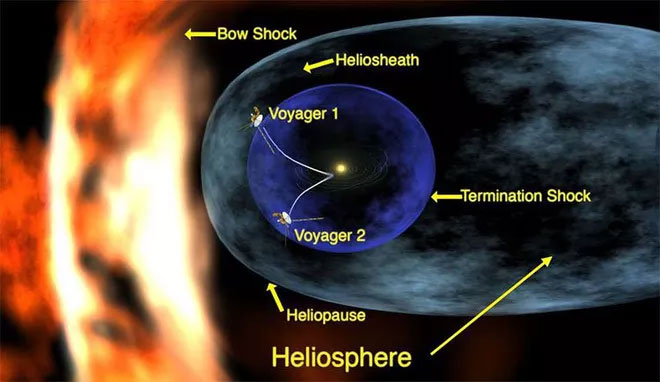Physicists calculate the number of years we need to travel interstellar, so large that you will sigh boredom
When you are planning a journey, make sure you know how long the trip will take. And if mankind wants to travel interstellar, then this will be the time needed to reach the destination.
Some physicists have tried to calculate the exact time we will need, to reach other star systems in our galaxy, with existing spacecraft technology.
They looked specifically at four unmanned space probes that were launched into space by NASA (Pioneer 10 and 11, Voyager 1 and 2), the data obtained will tell us what humans will lose. how long to exit the Solar System.

Voyager 1 is about to move to the border of the Solar System.
It will take thousands of years for the probes to see a star system and send data back; then it will take millions more years for them to reach a star. In their paper, the researchers said: "The time it takes for one of the four NASA spacecraft to reach a star is about 10 20 [one trillion billion years] , so their journey is longer." very long".
To reach this conclusion, Coryn Bailer-Jones from the Max Planck Astronomical Institute in Germany and Davide Farnocchia from NASA's Jet Engine Laboratory, studied the latest data from the Gaia space observatory.
The latest updated map of Gaia has the position of about 7.2 million stars. From that data, they combined with the expected voyages of the Pioneer 10, Pioneer 11, Voyager 1 and Voyager 2 space probes, which were launched between 1972 and 1977.
The results show that, in the next million years, these four probes may "face" about 60 stars. And to "relatively close" to 10 stars - although called "relatively close" , they still need about 2 more parsecs (parsec is a unit of length used in astronomy), ie more than 6 light-years, or more than 56 trillion more miles to really get there.
To make it easy to imagine, let's look at the distance from the Earth to Pluto (the outermost planet of the Solar System): just over 7 billion km. The current distance from the probes to the nearest star is 7 billion km.
Pioneer 10 is the first prospective ship: it is expected to encounter the dwarf "HIP 117795" in the constellation Cassiopeia, of course that is 90,000 years later. Even then, it would still be about 0.223 parsec (about 7 trillion miles) from HIP 117795 and would fly past the dwarf relative speed up to 291 km / s.

In fact, future space missions do not necessarily follow the path of these four probes - our nearest star system, Alpha Centauri, is only about 4.37 light-years away or 1, 34 parsec. With current technology, if we launch a ship similar to Voyager 1, it can appear in Alpha Centauri in about 80,000 years.
Scientists' calculations are not yet accurate in the future, because our technology is developing rapidly, but it has shown the great scale of the galaxy (not to mention the whole of the Universe), and the first thing that humanity needs to do is to escape the Solar System.
It may take us many generations to reach the nearest stars, at least until scientists have found a way to develop "Warp Drive" - the instantaneous displacement engine has been studied. . in books and science fiction movies.

Technology fiction: Warp Drive.
Some experts actually think that maybe one day we will be able to travel at the speed of light (and come to Alpha Centauri after four years or so), but this is purely theoretical until current time. So for now, maybe we should just focus on Mars.
Currently, this research has not been censored yet, you can refer to arXiv.org in advance.
- What is a plasma rocket and why can it be interplanetary with it?
- New hypothesis: We can use energy from black holes to travel to the Universe
- The latest messages from interstellar travel objects that we observe
- Why do we sigh?
- Interstellar travel objects have no alien signals
- The smallest satellite opens the way of interstellar travel
- People will die if not often sigh
- The mysterious factor for the journey to the interstellar environment
- Spacecraft can fly forever without fuel thanks to this
- Sadness spawned an initiative
- When can humans set foot outside the solar system?
- America dreams of traveling to the stars
- The first interstellar object in the solar system 4.5 billion years
- The intense past of interstellar traveling objects visits the solar system
 Van Allen's belt and evidence that the Apollo 11 mission to the Moon was myth
Van Allen's belt and evidence that the Apollo 11 mission to the Moon was myth The levels of civilization in the universe (Kardashev scale)
The levels of civilization in the universe (Kardashev scale) Today Mars, the sun and the Earth are aligned
Today Mars, the sun and the Earth are aligned The Amazon owner announced a secret plan to build a space base for thousands of people
The Amazon owner announced a secret plan to build a space base for thousands of people